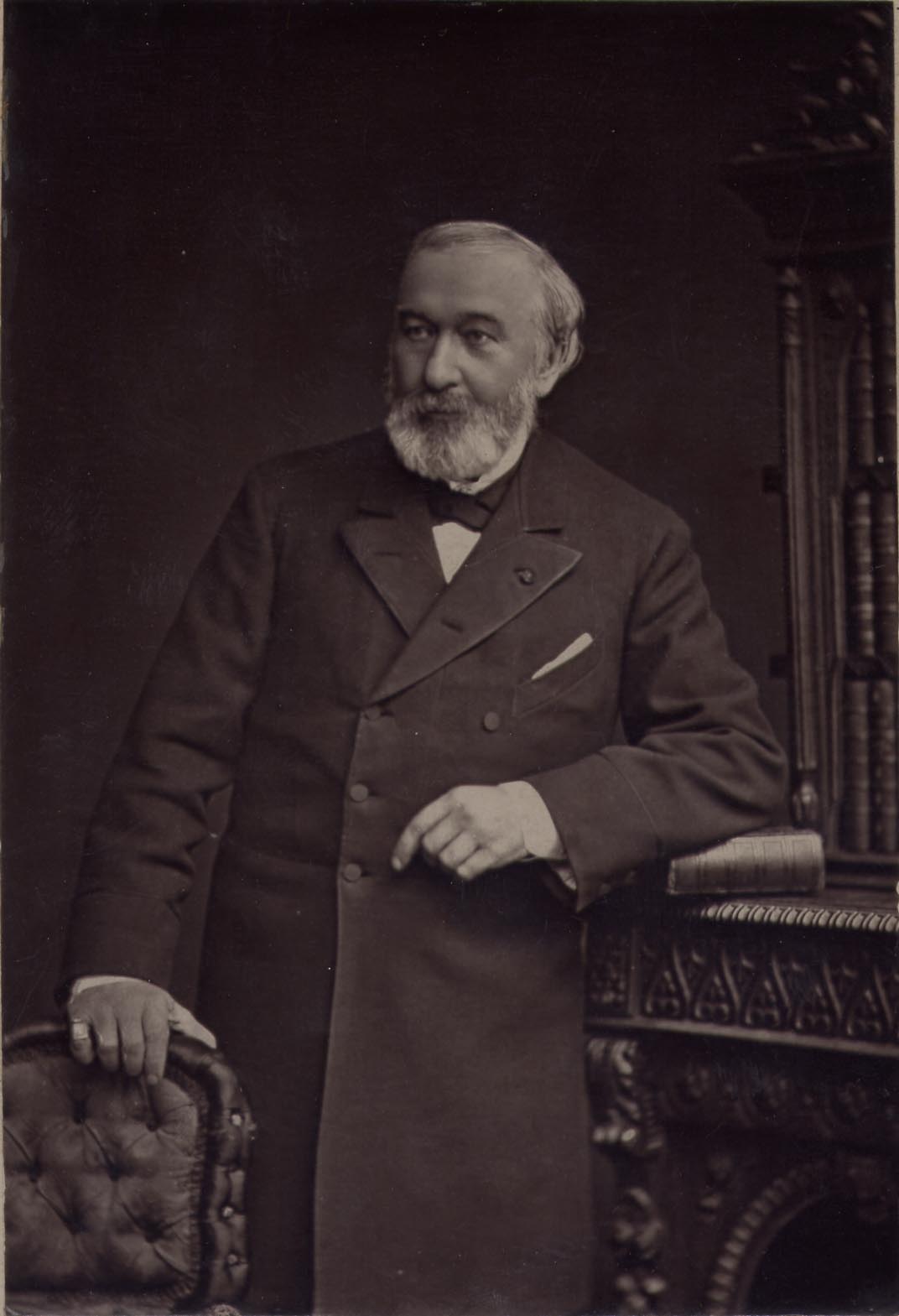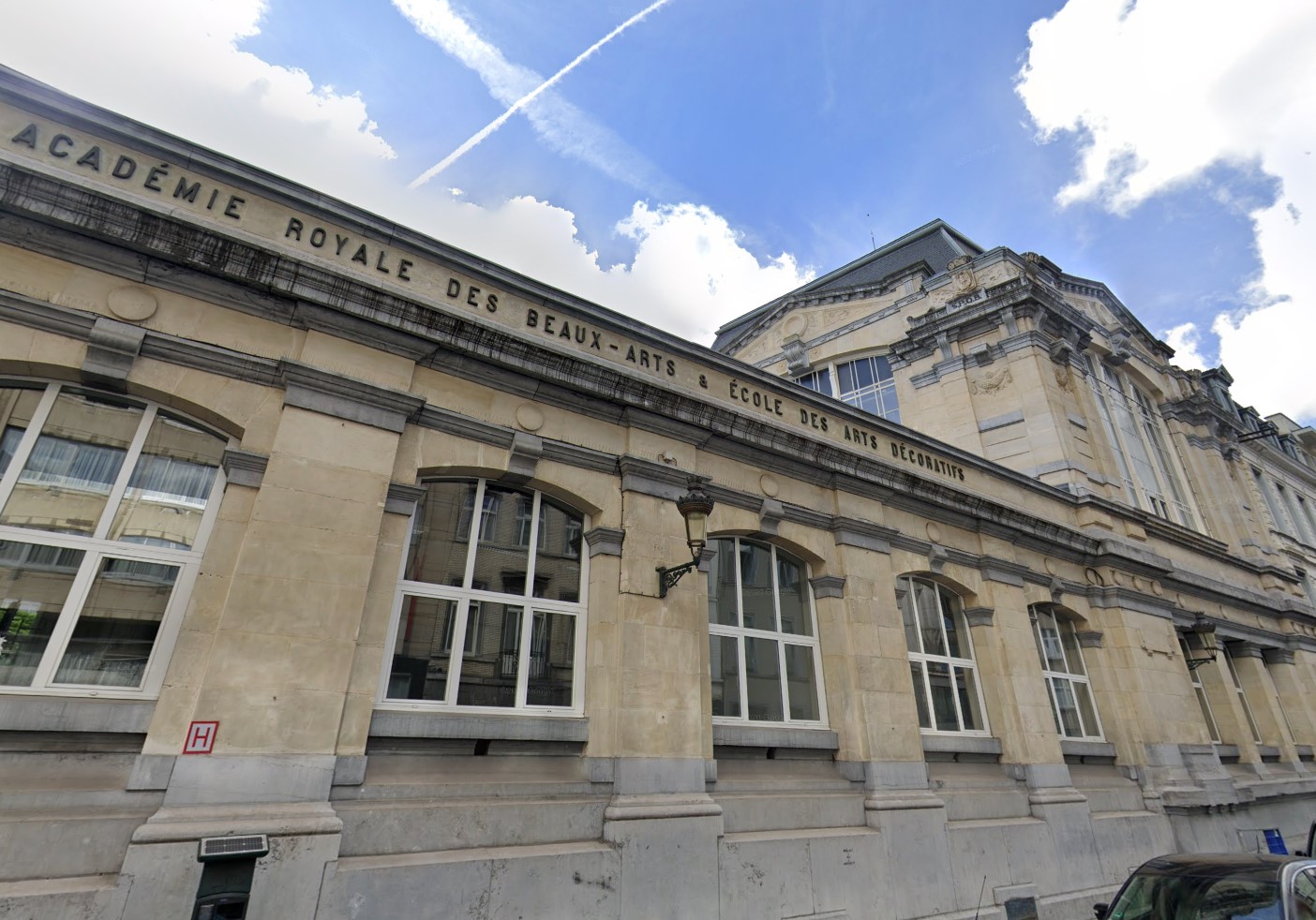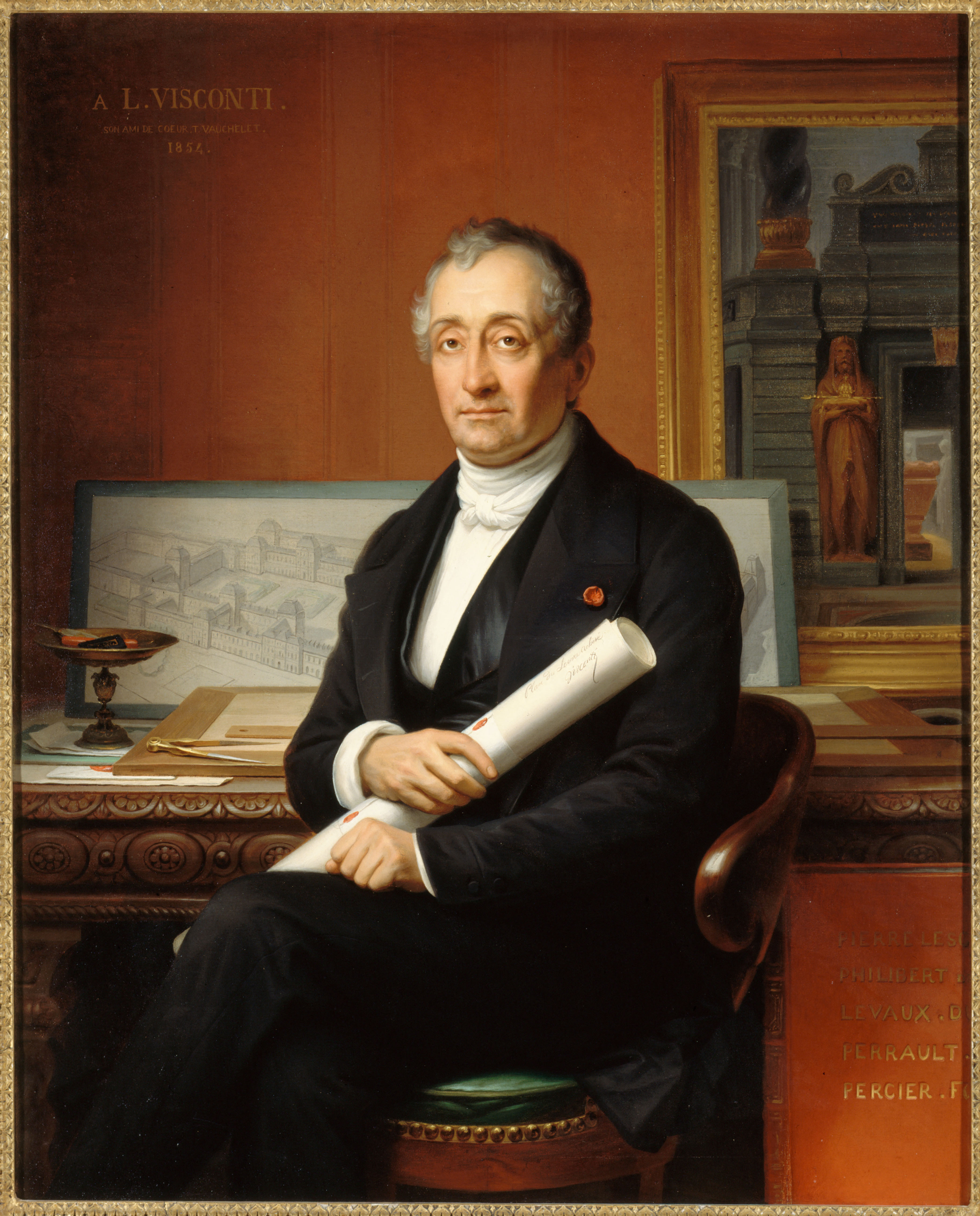|
Poelaert
Joseph Poelaert (21 March 1817 – 3 November 1879) was a Belgian architect. He was entrusted with important projects in Brussels, such as Saint Catherine's Church, the Church of Our Lady of Laeken, the Congress Column, the Royal Theatre of la Monnaie and above all, the Palace of Justice. He was also the great-uncle of the architect Henri Van Dievoet. Life Early life Joseph Poelaert was born in Brussels on 21 March 1817. His father was Philip Poelaert (1790–1875), a former architecture student at the Royal Academy of Fine Arts in Brussels. The young Poelaert also trained there under Tilman-François Suys, and then in Paris under Louis Visconti and Jean-Nicolas Huyot. He first came to attention with his winning competition entry for the Congress Column in 1849. He was made city architect of Brussels in 1856. Palace of Justice Poelaert's most significant commission was the colossal Palace of Justice of Brussels, the largest single building constructed in the 19th cent ... [...More Info...] [...Related Items...] OR: [Wikipedia] [Google] [Baidu] |
Palais De Justice, Brussels
The Palace of Justice of Brussels (french: Palais de Justice de Bruxelles, ; Dutch: ) or Law Courts of Brussels, nl, Rechtbank van Brussel is a courthouse in Brussels, Belgium. It is the country's most important court building, seat of the judicial ''arrondissement'' of Brussels, as well as of several courts and tribunals, including the Court of Cassation (Belgian supreme court), the Court of Assizes (highest criminal court), the Court of Appeal of Brussels (appellate court), the Tribunal of First Instance of Brussels (general jurisdiction), and the Bar Association of Brussels. Designed by the architect Joseph Poelaert, in an eclectic style of Greco-Roman inspiration, to replace an older courthouse, the current building was erected between 1866 and 1883. With a ground surface of , the edifice is reputed to be the largest constructed in the 19th century and remains one of the largest of its kind. The total cost of the construction, land, and furnishings was somewhere in t ... [...More Info...] [...Related Items...] OR: [Wikipedia] [Google] [Baidu] |
Marollen
The ( French, ) or (Dutch, ) is a popular historic neighbourhood of downtown Brussels, Belgium, situated between the Palace of Justice to its south-east, the Chapel Church to its north and the Halle Gate to its south. Its inhabitants are called ''Marolliens''. Lying at the heart of Marolles are the Place du Jeu de Balle/Vossenplein, home to the ''Old Market'', and the Cité Hellemans collective housing complex. Major arteries of the district include the /, the / and the /. This area is served by Brussels-Chapel railway station and Brussels-South railway station, as well as by the metro and ''premetro'' (underground tram) station Porte de Hal/Hallepoort on lines 2, 3, 4 and 6. The traditional Brabantian dialect of Brussels (known as Brusselian, and also sometimes referred to as Marols or Marollien) was widely spoken in the Marolles until the 20th century. It still survives among a small minority of inhabitants called ''Brusseleers'' (or ''Brusseleirs''), many of them q ... [...More Info...] [...Related Items...] OR: [Wikipedia] [Google] [Baidu] |
Saint Catherine's Church, Brussels
nl, Sint-Katelijnekerk , native_name_lang = , image = Brussel Sint-Katelijnekerk.jpg , image_size = 250px , alt = , caption = , pushpin map = , pushpin label position = , pushpin map alt = , pushpin mapsize = , relief = , map caption = , coordinates = , osgraw = , osgridref = , location = / B-1000 City of Brussels, Brussels-Capital Region , country = Belgium , denomination = Roman Catholic , previous denomination = , tradition = , religious institute = , churchmanship = , membership = , attendance = , website = , former name = , bull date = , founded date = , founder = , dedication = Saint Catherine , dedi ... [...More Info...] [...Related Items...] OR: [Wikipedia] [Google] [Baidu] |
La Monnaie
The Royal Theatre of La Monnaie (french: Théâtre Royal de la Monnaie, italic=no, ; nl, Koninklijke Muntschouwburg, italic=no; both translating as the "Royal Theatre of the Mint") is an opera house in central Brussels, Belgium. The National Opera of Belgium, a federal institution, takes the name of this theatre in which it is housed—La Monnaie in French or De Munt in Dutch—referring both to the building as well as the opera company. As Belgium's leading opera house, it is one of the few cultural institutions which receive financial support from the Federal Government of Belgium. Other opera houses in Belgium, such as the Vlaamse Opera and the Opéra Royal de Wallonie, are funded by regional governments. La Monnaie is located on the Place de la Monnaie/Muntplein, not far from the Rue Neuve/Nieuwstraat and the Place de Brouckère/De Brouckèreplein. The current edifice is the third theatre on the site. The facade dates from 1818 with major alterations made in 1856 and 19 ... [...More Info...] [...Related Items...] OR: [Wikipedia] [Google] [Baidu] |
Congress Column
The Congress Column (french: Colonne du Congrès, nl, Congreskolom) is a monumental column in Brussels, Belgium, commemorating the creation of the Belgian Constitution by the National Congress of 1830–31. Inspired by Trajan's Column in Rome, it was erected between 1850 and 1859, on the initiative of the then-Prime Minister of Belgium, Charles Rogier, according to a design by the architect Joseph Poelaert. At the top of the column is a statue of Belgium's first monarch; King Leopold I, and at its base, the pedestal is surrounded by statues personifying the four freedoms guaranteed under the Constitution. The Belgian Tomb of the Unknown Soldier with an eternal flame lies at its foot.The oldest film material in this movie (9:03 - 9:49 min), is about the burial of the coffin of the Unknown Soldier at the monument to the Congress Column on November 11, 1922. The column is located on the /; a small square adjacent to the Rue Royale/Koningsstraat, in the Freedom Quarter. This are ... [...More Info...] [...Related Items...] OR: [Wikipedia] [Google] [Baidu] |
Henri Van Dievoet
Henri van Dievoet (, 19 January 1869 – 24 April 1931) was a Belgian architect. Biography Early life Van Dievoet was born into an old family of Brussels descended from the Sweerts lineage, one of the Seven Noble Houses of Brussels, which had already shone in the fine arts at the time of Louis XIV. His great-grand-uncles were the goldsmith Philippe Van Dievoet and the sculptor Peter Van Dievoet, one of the creators of the Grand-Place of Brussels. Joseph Poelaert was his great-uncle. Education Henri Van Dievoet enrolled at the Académie Royale des Beaux-Arts on 1 August 1884 and took courses there until 1892. he was a brilliant student and distinguished himself by received numerous awards: the geometry award, the perspective award, the construction award, the archaeology award, the art history award, the hygiene award, the jurisprudence award, and the architecture history award. He also received a formation by architect Ernest Acker, who would eventually be a witness at ... [...More Info...] [...Related Items...] OR: [Wikipedia] [Google] [Baidu] |
Church Of Our Lady Of Laeken
nl, Onze-Lieve-Vrouwekerk van Laken , native_name_lang = , image = Église Notre-Dame de Laeken (DSCF1248-DSCF1251).jpg , imagesize = 271 , imagelink = , imagealt = , caption = , pushpin map = , pushpin label position = , pushpin map alt = , pushpin mapsize = , relief = , map caption = , latd = , latm = , lats = , latNS = , longd = , longm = , longs = , longEW = , iso region = , coordinates = , osgraw = , osgridref = , location = Laeken, City of Brussels, Brussels-Capital Region , country = Belgium , denomination = Roman Catholic , previous denomination = , churchmanship ... [...More Info...] [...Related Items...] OR: [Wikipedia] [Google] [Baidu] |
Tilman-François Suys
Tilman-François Suys (in French) or Tieleman Frans Suys (in Dutch) (1 July 1783 – 22 July 1864) was a Belgian architect who also worked in the Netherlands. Biography Suys completed his architectural education in Paris, where he studied under Charles Percier and won the Prix de Rome in 1812. During his stay in Rome he became a protégé of King William I of the Netherlands the new king of the Belgian and Dutch provinces unified in the United Kingdom of the Netherlands. In 1817 he settled in Amsterdam and worked as an architect for the Dutch Crown. In this period his style shows the marks of the Empire style created for Napoleon by his teacher Charles Percier and Pierre François Léonard Fontaine. From 1825 onwards, Suys was employed on a series of royal commissions in Brussels, a city that, together with The Hague in the province of Holland, had been given the title of capital of the new established kingdom. His projects in Brussels were more severely neoclassical i ... [...More Info...] [...Related Items...] OR: [Wikipedia] [Google] [Baidu] |
Académie Royale Des Beaux-Arts
The Royal Academy of Fine Arts of Brussels (french: Académie Royale des Beaux-Arts - École supérieure des Arts de la Ville de Bruxelles (ARBA-ESA), nl, Koninklijke Academie voor Schone Kunsten van Brussel), is an art school established in Brussels, Belgium. It was founded in 1711. Starting from modest beginnings in a single room in Brussels' Town Hall, it has since 1876 been operating from a former convent and orphanage in the /, which was converted by the architect . The school has played an important role in training important local artists. History Origins Historically, artistic training in Brussels was organised in traditional workshops where masters would teach their skills to pupils. The masters needed to be registered with their local guild to be able to practice their craft. On 30 September 1711, the magistrate of the City of Brussels gave the guilds of painters, sculptors, weavers and other amateurs the use of a room in Brussels' Town Hall to teach drawing class ... [...More Info...] [...Related Items...] OR: [Wikipedia] [Google] [Baidu] |
Laeken Cemetery
Laeken Cemetery (french: Cimetière de Laeken, nl, Begraafplaats van Laken) in Brussels, Belgium, is the city's oldest cemetery still in function and the resting place of the Belgian Royal Family. It is known as the ''Belgian Père Lachaise'', after Paris' notorious cemetery, because it is the burial place of the rich and the famous and for the abundance of its funerary heritage. Description The installation of the Belgian Royal Family in 1831 and the burial of Queen Louise in 1850 contributed to the appeal of Laeken. The cemetery houses very fine examples of 19th-century funerary art and also features an original bronze cast of Auguste Rodin's ''Thinker'', purchased in 1927 by the antiquarian and art collector Josef Dillen to use as his own memorial. Next to the entrance, there is a small museum dedicated to the sculptor Ernest Salu and his successors. The adjacent Church of Our Lady of Laeken is the site of the , consecrated in 1872. Notable interments Personalitie ... [...More Info...] [...Related Items...] OR: [Wikipedia] [Google] [Baidu] |
Louis Visconti
Louis Tullius Joachim Visconti (Rome February 11, 1791 – December 29, 1853) was an Italian-born French architect and designer. Life Son of the Italian archaeologist and art historian Ennio Quirino Visconti, Visconti designed many Parisian residences, public buildings and squares, including the Place Saint Sulpice and the overall design of the Fontaine Molière, and was briefly the official architect for the Louvre under Napoleon III. He is probably most famed for designing the 1842 tomb of Napoleon at Les Invalides. His students include Joseph Poelaert, designer of the Palais de justice de Bruxelles. Louis Visconti came from a famous family of archaeologists - his grandfather Giambattista Antonio Visconti (1722–1784) had founded the Vatican Museums and his father, Ennio Quirino Visconti (1751–1818), was a curator. Ennio and his family moved to Paris in 1798 and were naturalised as French citizens in 1799, with Ennio becoming a curator of antiquities and ... [...More Info...] [...Related Items...] OR: [Wikipedia] [Google] [Baidu] |
Laeken
() or () is a residential suburb in the north-western part of the Brussels-Capital Region, Belgium. It belongs to the List of municipalities of the Brussels-Capital Region, municipality of the City of Brussels and is mostly identified by the Belgian postal code: 1020. Prior to 1921, it was a separate municipality. Toponymy Etymology The name ''Laeken'' ( nl, Laken, link=no) derives from the Germanic ''Lacha'' or ''Lache'' ("water", "lake"), because the Molenbeek brook at the time formed a network of ponds at this height. The oldest mention of the village is in a diploma from 1080, where the name ''Gilbert de Lacha'' appears. There is also the mention ''Lachus'' in 1117. Main sights Royal Palace The Palace of Laeken, Royal Palace of Laeken, official home of the Monarchy of Belgium, Belgian Royal Family, is situated in Laeken. The palace was built in 1782–1784 by the French architect and urbanist Charles de Wailly. It was partly destroyed by fire in 1890, and was rebuil ... [...More Info...] [...Related Items...] OR: [Wikipedia] [Google] [Baidu] |

_(14773620895).jpg)





